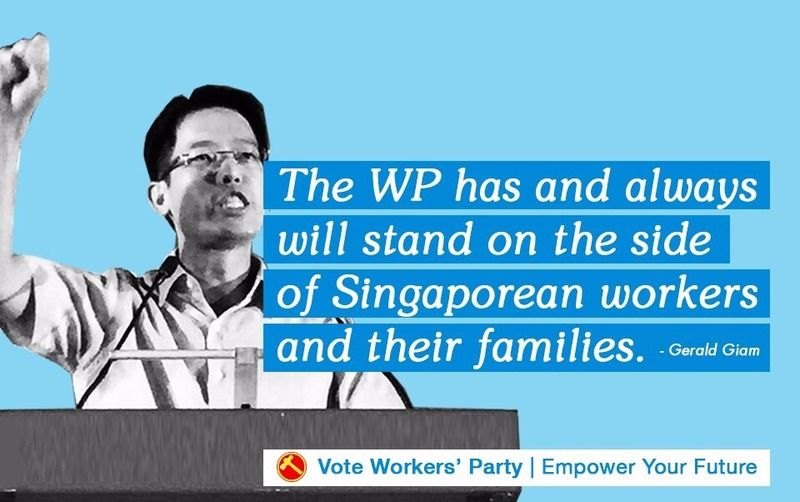各位义顺集选区的选民。晚上好!我是严燕松。我是工人党在东海岸集选区的候选人。
Residents of Nee Soon GRC, good evening! My name is Gerald Giam and I am the Workers’ Party candidate for East Coast GRC.
During the first rally, I shared with you why it is important to elect in a sizeable number of credible opposition MPs into Parliament. This is so that we can better scrutinise government policies and build up a credible alternative to insure Singapore against a decline in the ruling party.
But what is a “sizeable number”?
From 1981 to 1991, we had only one or two opposition MPs. Was that enough?
From 1991 to 1997, we had four opposition MPs, but it fell back to two in 1998. Was that enough?
In the last Parliament, we had seven elected opposition MPs. Do you think that was enough?
Let me share with you some numbers to give you a sense of how many opposition MPs are needed to properly empower you, the people.
To pass a law in Parliament, at least 45 MPs are needed, or more than half the total MPs present.
To prevent the Government from changing the Constitution and introducing things like the GRC system, we need at least 30 elected MPs.
To have an opposition MP shadow each Ministry, we need 16 MPs. But this is not even enough to shadow all the ministers, ministers of state and parliamentary secretaries currently in the government.
So, my friends, seven is certainly not enough. We need many more opposition MPs in Parliament to form a proper check on the power of the PAP. Come September 11th, we ask for you to vote all 28 Workers’ Party candidates into Parliament.
Having seven, 16 or 28 Workers’ Party MPs in Parliament will not cause gridlock, because we are a party that puts the country’s interests first and foremost. We will debate policy issues rationally and responsibly, and will not resort to personal attacks.
Tonight, I want to continue sharing with you more policy proposals from the Workers’ Party that will better the lives of Singaporeans, including ordinary citizens like you and me.
National Minimum Wage
The PAP has responded to our proposal for the introduction of a national minimum wage. I am glad that we have gotten this important conversation going. It is an issue that affects the lives of well over 110,000 full-time workers who get earn less than $1,000 a month.
The PAP’s counter-arguments revolve around the following: One, it will cause job losses. Two, we already have Workfare. And three, we have the Progressive Wage Model.
Let me address all three in turn.
First, on job losses. There have been many studies that have shown that minimum wages set at modest levels do not lead to job losses. A “modest” level means less than 50% of median full-time income. In Singapore, this will be $1,885 . The minimum wage we are proposing is about $1,000 a month. This is only 27% of the median income – well within the “modest” range. So there should be no fear of job losses.
Furthermore, this would be an ideal time to introduce a minimum wage, because we are reducing the inflow of foreign labour, so there are more jobs than there are people to fill them. Raising wages will attract more Singaporeans into the workforce to fill these positions. It could also improve productivity and reduce turnover, as workers are more motivated in their jobs and are less likely to switch jobs. It is therefore “win-win” for workers, employers and the economy.
Second, on Workfare, which is a wage supplement for low wage workers. The Workers’ Party supports Workfare. We are not proposing that the minimum wage replaces Workfare, but complements it.
A minimum wage together with Workfare will ensure that both employers and the government do their part to uplift the incomes of our low wage workers. A worker on the minimum wage should still continue receiving Workfare, although the Workers’ Party proposes that we double the cash proportion of Workfare so that workers have more disposable income to spend on their daily needs.
Third, on the Progressive Wage Model or PWM. I debated this in Parliament last year and won’t go into the details. The PWM is essentially a minimum wage for specific industry sectors. Its introduction is an admission by the PAP government that we cannot wait indefinitely for wages at the bottom to increase naturally.
However, the PWM will be implemented in only three industry sectors, covering 70-80,000 workers. That still leaves over 30,000 workers who will continue earning less than $1,000 a month. A national minimum wage will ensure that all Singapore workers will earn a decent living wage to meet their needs.
Public transport
I would now like to turn to another issue that affects many Singaporeans: public transport and in particular, MRT breakdowns.
Like many of you, I don’t own a car and I usually take public transport. I got caught in both the massive MRT breakdown in December 2011 and the even bigger one in July this year, and many other delays in between. I’m sure many of you will understand that frustrating feeling of having to get out of a stalled train, taking a long route to your destination and being late for work.
I asked the Transport Minister in Parliament whether there was a delay in the replacement of the ageing parts of the MRT system that could be the cause of the frequent breakdowns we have been experiencing the last few years. I discovered some surprising things along the way.
I found out that a key component of the MRT tracks called the ‘sleepers’ are designed to last 15 to 25 years. They have to be replaced when they are near the end of their lifespan, or when they show signs of significant wear and tear.
Do you know when the sleepers on the North-South and East-West MRT line started to be replaced? In December 2012, more than 25 years after operations started, and it takes another 4 years to replace all the sleepers.
The replacement programme for the ‘third rail’, which was the likely cause of the July incident, was also delayed until 2017. The signalling system too had a maximum lifespan of 15 years, but a contractor was not appointed to replace it until 2012 when it was 25 years old.
The problem, it seems, is not just that maintenance of the MRT lines was lacking, but that SMRT and the government, which owns the rail assets, did not adequately plan for the renewal and replacement of ageing rail assets before their end-of-life. Is this what is called forward thinking and anticipating problems before they occur?
The Workers’ Party calls for a not-for-profit and government-owned National Transport Corporation to own and manage all rail and bus assets. This will minimise costs and achieve efficiency in the management of these assets. A dedicated entity that manages rail and bus assets will better ensure that maintenance and renewal are done in a timely fashion, insulated from the profit pressures that public transport operators face.
Fellow Singaporeans, these are just a few of the over 130 proposals that the Workers’ Party has put forward in our Manifesto. Our candidates will be sharing more of these proposals in this and subsequent rallies. In doing so, I hope that you can see that we are a party that brings to the table practical proposals that will improve your lives.
Vote for the Workers’ Party, to empower your future!
投工人党一票。掌握民权,把握未来!
Memperkasakan masa depan anda!
Thank you.




